The Varied Thrush is a beautiful pumpkin orange and gray bird with black on the head and breast. A quintessential and common species of the Pacific Northwest, it breeds in coniferous forests in Alaska, western Canada, Washington, Oregon, and northwestern California.
The Varied Thrush is not closely related to other thrush species in North America
On its breeding grounds, the ethereal whistled song of the Varied Thrush lends a mystical touch to the towering, moss-draped spruce, Douglas Fir, and Cedar forests it prefers. In winter, this species migrates to additional habitats in California and occasionally reaches northern Baja California.
On this page
Breeding Male
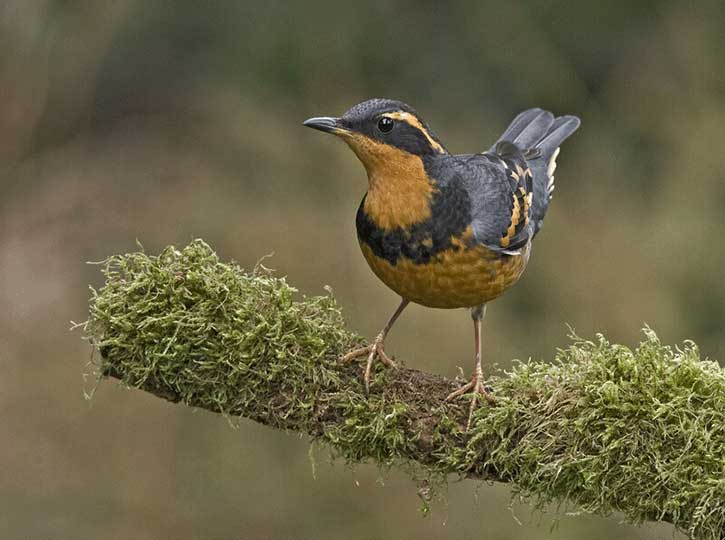
Varied Thrush © Alan Wilson
The male Varied Thrush has a pumpkin orange face and underparts with a thick black line through the eye and on the breast. It also has orange markings on gray wings, and a slate-gray cap, back, and tail. It is slightly smaller than the female.
Female
The female Varied Thrush is similar to the male but is duller, has more spotting on the underparts, and the cap, back, and tail are brownish or olive-brown. The female is also slightly larger than the male.
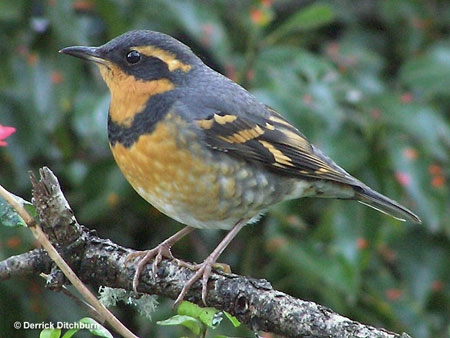
Juvenile
The juvenile Varied Thrush looks very much like the adult female. They hatch after 12 days and leave the nest around two weeks after hatching.
Habitat
The Varied Thrush breeds in wet coniferous forests in Alaska, western Canada, and the Pacific Northwest, and winters in coniferous woodlands, parks, riparian zones, and other woodlands with fruiting trees. They build their nests on the ground, in bushes, and on branches close to the trunk of a small conifer, usually six to twelve feet above ground.
Diet
Varied Thrushes eat a variety of insects and other small creatures during the summer months, and then switch to eating berries and other fruits on their wintering grounds.
They also eat acorns. This pretty thrush forages on the ground for bugs, worms, and other arthropods by carefully lifting and moving leaves with its bill and then snatching the bugs and worms that it finds. The spots it chooses to forage in tend to be open areas in the forest understory with plenty of leaf litter.
When feeding on salmonberries, snowberries, apples, and other fruits, the Varied Thrush quietly picks them with its bill while perched in shrubs and trees, or during brief hovering flight. In summer, they forage alone but in winter, they can form flocks, and can also visit feeders, sometimes, in eastern states and other places, far from their normal range.
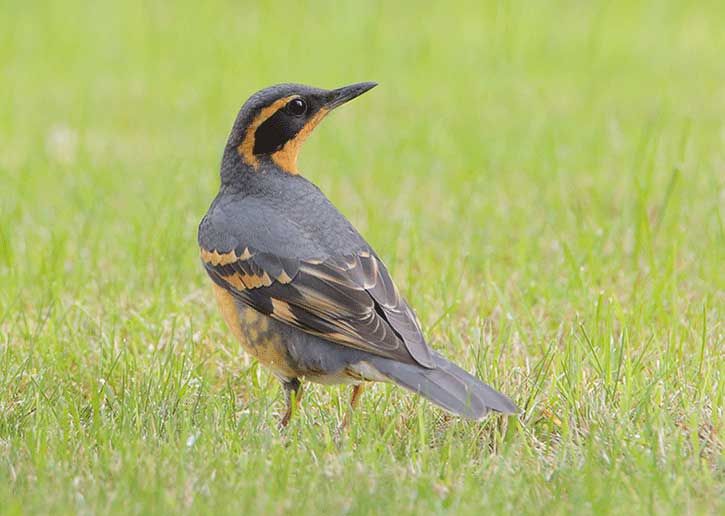
Varied Thrush © Greg Lavaty
Behavior
On breeding grounds, male Varied Thrushes will fight with other Varied Thrushes over breeding territories but tend to be solitary birds.
In winter, they often flock with others of their own kind as well as other thrush species, often squabbling with each other and other bird species at fruiting trees and feeders.
This medium-sized songbird is mostly preyed on by Northern Goshawk, Cooper’s Hawk, Sharp-shinned Hawk, and Merlin. They can be shy around people on their breeding grounds but are often tame at feeders and during the winter.
Range (and seasonal changes)
The Varied Thrush breeds in coniferous forests in Alaska, western Canada, and in the northwestern USA, and mostly winters in the Pacific Northwest and California.
Occasionally, wintering flocks reach Mexico, Idaho, Nevada, and other places outside of their normal range. Individuals show up every year in the eastern USA or Canada thousands of miles from typical wintering areas.
These movements may be related to lack of fruit in their usual range.
Wing shape
The wings of the Varied Thrush are fairly long and suited to flying long distances in search of fruiting trees. They have a quick, direct flight and a wingspan of 13 to 17 inches.
Fun Facts
- The spiritual meaning of the Varied Thrush is one of internal strength, adaptability, and curiosity. This bird species is also a representation of being flexible and adapting to difficult situations.
- For unknown reasons, populations of the Varied Thrush increase and then decrease every two years.
- The Varied Thrush is not closely related to other thrush species in North America. It looks more like some thrush species in Asia and even sounds somewhat like the White’s Thrush of northeastern Asia.
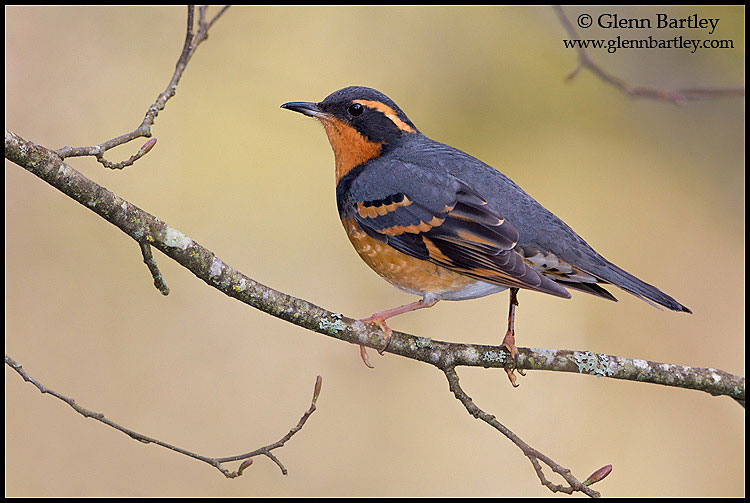
Call
The male Varied Thrush sings an ethereal and scratchy whistled note of around two seconds in duration, waits for several seconds, and then sings another similar whistled note on another pitch. Male and females also give short “churr‘ and “vree” calls.
FAQ
Are Varied Thrushes rare?
No, Varied Thrushes are fairly common in western Canada and the western USA.
Where are Varied Thrush found?
The Varied Thrush is found in coniferous forests and other woodlands and gardens from Alaska to western Canada, Washington, Oregon, and California.
What foods do Varied Thrush eat?
Varied Thrushes eat worms, insects, and other small creatures, and fruit.
What does a Varied Thrush look like?
The Varied Thrush looks a bit like an American Robin but has orange in the wings, an orange face with a black line through the eye, and a black mark on an orange breast.

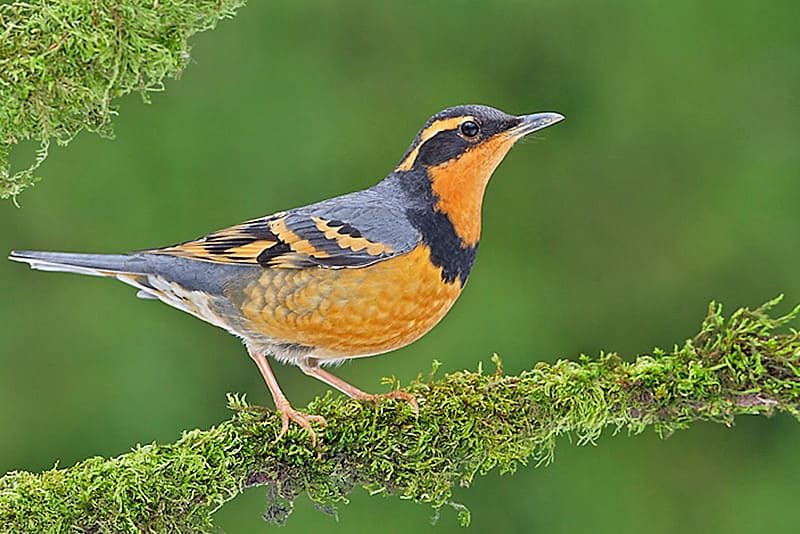

Michael
Monday 15th of January 2024
Good article. I was wondering if I was seeing an immature red shafted flicker or a cross with a towhee, but nope, Varied Thrush! Thanks. Upper Willamette Valley, Oregon.